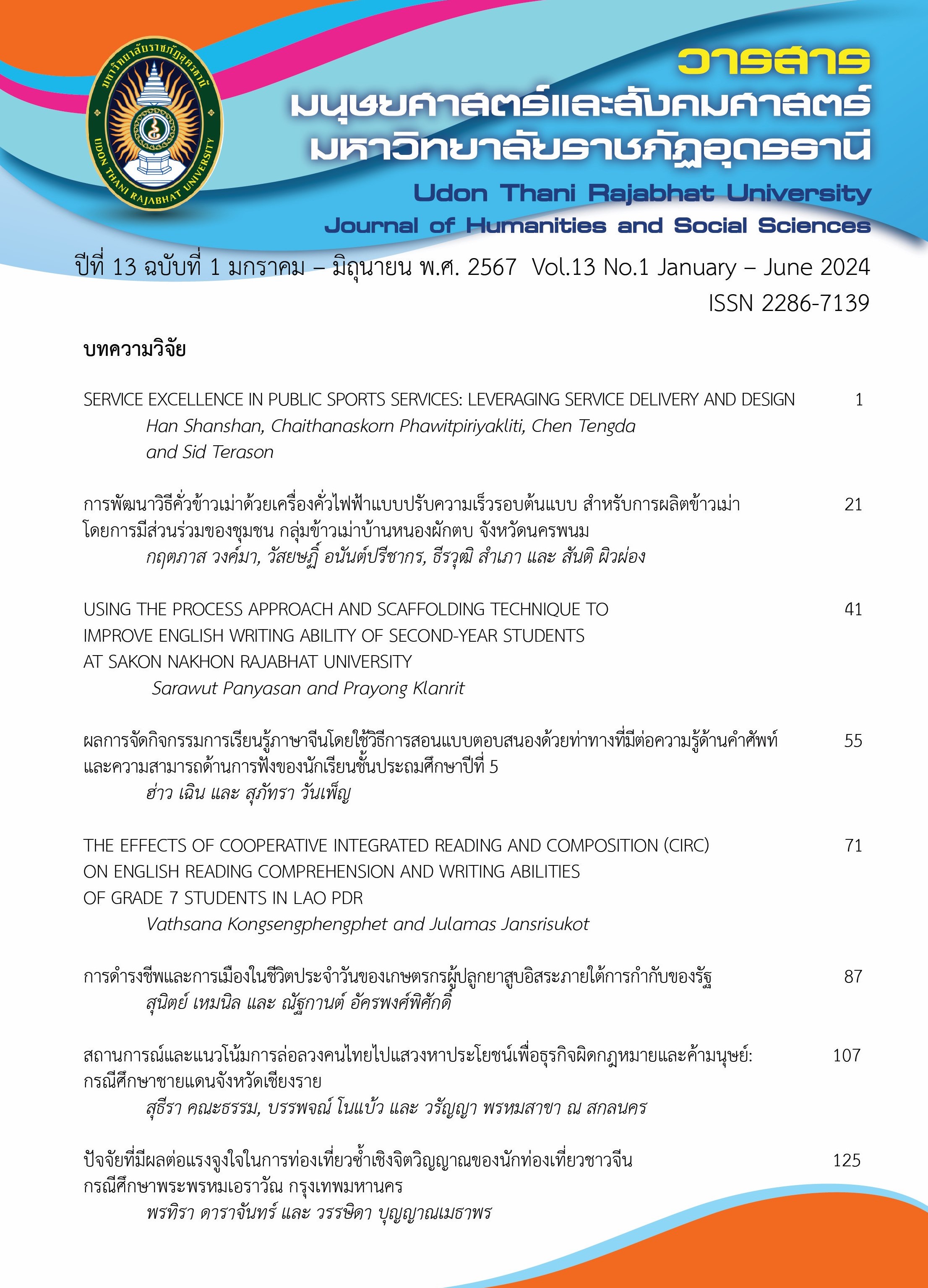SERVICE EXCELLENCE IN PUBLIC SPORTS SERVICES: LEVERAGING SERVICE DELIVERY AND DESIGN
Main Article Content
บทคัดย่อ
This research provides an in-depth study of the current status and future development trends of public sports service quality management in rural Zhuang ethnic regions of China, with the goal of improving service quality, and explores the significant impacts of competency, public sports service delivery, and service design on public sports service quality. By analyzing the data using SmartPLS, the study verified the validity of the measurement tools and the significant relationships between the key variables in the structural model. The results of the study indicate that competency has a significant positive impact on Public sports service delivery and service design, which in turn have a positive effect on public sports service quality. The study validated the indirect effects through the Bootstrap program, further supporting the pathways of competency, service design and public sports service delivery on public sports service quality. Finally, the study provides strong guidance for improving public sports service quality in rural China at both the theoretical and practical levels, and offers new perspectives and suggestions for academic research and policy formulation in related fields.
Article Details
เอกสารอ้างอิง
Akerson, M. (2014). Investigating personal fitness trainers' qualifications. Electronic Theses and Research. 3014. https://stars.library.ucf.edu/etd/3014.
Clatworthy, S., Kundi, G., & Petty, D. (2009). Service design: time to bring designers into the core of the service design process. Paper presented at the ServDes, 2009, London, UK. https://doi.org/10.6084/m9.figshare.7744048.v1.
Churchill Jr, G. A., & Surprenant, C. (1982). An investigation into the determinants of customer satisfaction. Journal of Marketing Research, 19(4), 491–504. https://doi.org/10.1177/002224378201900410.
Ferris, J. M., & Graddy, E. (1994). Organizational choices for public service supply. Journal of Law, Economics, & Organization, 10(1), 126–141. https://doi.org/10.1093/jleo/10.1.126.
Franke, G., & Sarstedt, M. (2019). Heuristics versus statistics in discriminant validity testing: a comparison of four procedures. Internet Research, 29(3), 430–447. https://doi.org//10.1108/IntR-12-2017-0515.
Hahn, E. D., & Ang, S. H. (2017). From the editors: New directions in the reporting of statistical results in the Journal of World Business. Journal of World Business, 52(2), 125–126. https://doi.org/10.1016/j.jwb.2016.12.003.
Hair, J. F., Thomas, G., Hult, M., Ringle, C. M., & Sarstedt, M. (2017). A Primer on partial least squares structural equation modeling (2nd ed.). Sage.
Hair, J., Risher, J., Sarstedt, M., & Ringle, C. (2019), When to use and how to report the results of PLS-SEM. European Business Review, 31(1), 2–24. https://doi.org/10.1108/EBR-11-2018-0203.
Henseler, J., Ringle, C., & Sarstedt, M. (2015). A new criterion for assessing discriminant validity in Variance-based structural equation modeling. Journal of the Academy of Marketing Science, 43(1), 115–135. https://doi.org/10.1007/s11747-014-0403-8.
Huang, J. (2018). A Study on the Relationship between Fitness Coaches' Competence and Customer Satisfaction in Fitness Clubs in Fuzhou (Master's thesis). Fujian Normal University, (1)10–13.
Jiang, M., & Wen, S. (2011). On constructing a public service system covering the entire population. Changbai Journal, (3), 77–79.
Shostack, G. L. (1982). How to design a service. European journal of Marketing, 16(1), 49–63. https://doi.org/10.1108/EUM0000000004799.
McClelland, D. C. (1973). Testing for competence rather than for "intelligence". American Psychologist, 28(1), 1–14. https://doi.org/10.1037/h0034092.
Nelson, J. B. (1997). The boundaryless organization: Implications for job analysis, recruitment, and selection. Human resource planning, 20(4), 39–49.
Parasuraman, A., Zeithaml, V. A., & Berry, L. L. (1985). A conceptual model of service quality and its implications for future research. Journal of Marketing, 49(4), 41–50. https://doi.org/10.2307/1251430.
Pu, X. (2020). Status and satisfaction survey of public sports service supply in Kunming City (Master's thesis). Yunnan University. https://doi.org/10.27456/d.cnki.gyndu.2020.000028.
Prychitko, D. L. (1996). Whither socialism?. Cato Journal, 16(2), 280.
Rainey, H. G., & Steinbauer, P. (1999). Galloping elephants: Developing elements of a theory of effective government organizations. Journal of Public Administration Research and Theory, 9(1), 1–32. https://doi.org/10.1093/oxfordjournals.jpart.a024401.
Ramayah, T., Cheah, J., Chuah, F., Ting, H., & Memon, M. A. (2018). Partial least squares structural equation modeling (PLS-SEM) using SmartPLS 3.0: An updated guide and practical guide to statistical analysis (2nd ed.). Pearson.
Sasser, W., Olsen, P., & Wyckoff, D. (1978). Management of service operations: Text and cases, 28(1), 156–183.
Toh, K. L., & Jamieson, L. M. (2000). Constructing and validating competencies of sport managers (COSM) instrument: A model development. Recreational Sports Journal, 24(2), 38–55. https://doi.org/10.1123/rsj.24.2.38.
Wen, Y. (2021). Research on the construction of rural community in the process of urban-rural integration in China. Renmin University of China Press.
Wang, Z. (2017). Construction experience of public sports service system in developed countries and its enlightenment to China. Sports Science, (05), 32–47. https://doi.org/10.16469/j.css.201705004.
Yuan, X., Zhang, R., & Wang, F. (2019). Public sports service quality: Concept definition and analysis of influencing factors. Journal of Tianjin University of Sport, 34(3), 232–237. https://doi.org/10.13297/issn1005-0000.2019.03.009.
Zhou, Z. (2000). Public sector quality management: New trends in the new century. Journal of National School of Administration, 2, 40–44. https://doi.org/1014063/cki.1008-9314.2000.02.0080.


